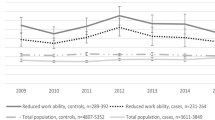Abstract
Purpose The aims of this study are: (1) to describe the prevalence of needed and implemented work adjustments in a representative sample of Dutch employees with a chronic disease; and (2) to assess the effects of needed and implemented work adjustments on sick leave. Methods The prevalence of work adjustments was assessed in employees with a chronic disease, aged between 15 and 65 years (n = 7,687) from the 2007 Netherlands Working Conditions Survey (NWCS). Of these, N = 2,631 employees participated in the Netherlands Working Conditions Cohort Study (NWCCS) measurements in 2008 and 2009. The NWCCS data were used to investigate the effects of work adjustments on sick leave. All data were self-reported. A repeated measures ANOVA was performed to analyse differences in sick leave in 2007, 2008 and 2009 between employees with and without a need for work adjustments, for those who reported an implemented work adjustment and those who did not. Results In 2007, the prevalence of implemented work adjustments among Dutch employees with a chronic disease was 22 %, while 30 % reported the need of a work adjustment. In employees with and without a need for work adjustments in 2007, a work adjustment in 2008 was significantly associated with a decrease in sick leave from 2007 to 2009. Conclusion The need for work adjustments is higher than the implementation of work adjustments. Work adjustments should be considered more often for employees with chronic diseases, because implementation of a work adjustment is associated with a decrease in sick leave.


Similar content being viewed by others
References
Jehoel-Gijsbers G. Incapacity for work and reintegration. The Hague: The Netherlands Institute for Social Research; 2007.
Koppes LLJ, De Vroome EMM, Mol MEM, Jansen BJM, Van Zwieten MHJ, Van den Bossche SNJ. Nationale Enquete arbeidsomstandigheden 2011. Methodologie en globale resultaten. [Netherlands working conditions survey 2011: Methodology and overall results]. Hoofddorp: TNO; 2012.
Baanders AN, Rijken PM, Peters L. Labour participation of the chronically ill: a profile sketch. Eur J Public Health. 2002;12:124–30.
Roskes K, Donders CG, van der Gulden JW. Health-related and work-related aspects associated with sick leave: a comparison of chronically ill and non-chronically ill workers. Int Arch Occup Environ Health. 2005;78:270–8.
Mitchell JM. The effect of chronic disease on work behavior over the life-cycle. South Econ J. 1990;56:928–42.
Bergh H, Baigi A, Mansson J, Mattsson B, Marklund B. Predictive factors for long-term sick leave and disability pension among frequent and normal attenders in primary health care over 5 years. Public Health. 2007;121:25–33.
De Zwart BC, Frings-Dresen MH, van Dijk FJ. Physical workload and the aging worker: a review of the literature. Int Arch Occup Environ Health. 1995;68:1–12.
Munir F, Jones D, Leka S, Griffiths A. Work limitations and employer adjustments for employees with chronic illness. Int J Rehabil Res. 2005;28:111–7.
Baanders AN, Andries F, Rijken PM, Dekker J. Work adjustments among the chronically ill. Int J Rehabil Res. 2001;24:7–14.
Franche RL, Severin CN, Hogg-Johnson S, Lee H, Cote P, Krause N. A multivariate analysis of factors associated with early offer and acceptance of a work accommodation following an occupational musculoskeletal injury. J Occup Environ Med. 2009;51:969–83.
Varekamp I, van Dijk FJ. Workplace problems and solutions for employees with chronic diseases. Occup Med (Lond). 2010;60:287–93.
Van Oostrom SH, Driessen MT, de Vet HC, Franche RL, Schonstein E, Loisel P, et al. Workplace interventions for preventing work disability. Cochrane Database Syst Rev. 2009;CD006955.
Driessen MT, Proper KI, Anema JR, Bongers PM, van der Beek AJ. Process evaluation of a participatory ergonomics programme to prevent low back pain and neck pain among workers. Implement Sci. 2010;5:65.
Van den Bossche SNJ, Koppes LLJ, Granzier JJM, De Vroome EMM, Smulders PGW. Nationale enquête arbeidsomstandigheden 2007: Methodologie en globale resultaten. [Netherlands working conditions survey 2007: methodology and overall results]. Hoofddorp: TNO; 2008.
Brooker AS, Cole DC, Hogg-Johnson S, Smith J, Frank JW. Modified work: prevalence and characteristics in a sample of workers with soft-tissue injuries. J Occup Environ Med. 2001;43:276–84.
Torp S, Nielsen RA, Gudbergsson SB, Dahl AA. Worksite adjustments and work ability among employed cancer survivors. Support Care Cancer. 2012;20:2149–56.
Boot CR, van Exel NJ, van der Gulden JW. “My lung disease won’t go away, it’s there to stay”: profiles of adaptation to functional limitations in workers with asthma and COPD. J Occup Rehabil. 2009;19:284–92.
Boot CR, Vercoulen JH, van der Gulden JW, Orbon KH, van den Hoogen H, Folgering HT. Sick leave in patients with obstructive lung disease is related to psychosocial and work variables rather than to FEV1. Respir Med. 2005;99:1022–31.
Leijten F, van den Heuvel S, Geuskens G, Ybema JF, de WA, Burdorf A, et al. How do older employees with health problems remain productive at work?: a qualitative study. J Occup Rehabil. 2013;23:115–24.
NVAB Richtlijn Psychische Problemen [Guideline mental health problems for occupational physicians]. Utrecht: Netherlands Society of Occupational Medicine; 2007.
Boot CR, Koppes LL, van den Bossche SN, Anema JR, van der Beek AJ. Relation between perceived health and sick leave in employees with a chronic illness. J Occup Rehabil. 2011;21:211–9.
De Vroome EMM, Koppes LLJ, Smulders PGW, Van den Bossche SNJ. Measuring sickness absence through self-report and register data: differences between the Netherlands working conditions survey and the statistics Netherlands data on sick leave (in Dutch). TSG Tijdschr Gezondh. 2010;2:71–8.
Author information
Authors and Affiliations
Corresponding author
Rights and permissions
About this article
Cite this article
Boot, C.R.L., van den Heuvel, S.G., Bültmann, U. et al. Work Adjustments in a Representative Sample of Employees with a Chronic Disease in the Netherlands. J Occup Rehabil 23, 200–208 (2013). https://doi.org/10.1007/s10926-013-9444-y
Published:
Issue Date:
DOI: https://doi.org/10.1007/s10926-013-9444-y




